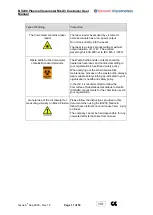
BV200 Plasma Viscometer Mk2/3 Customer User
Manual
Issue 9
th
Sep 2020 - Rev 1.8
Page 16 of 53
Benson Viscometers will move the unit safely using the following instructions:
Safely remove all connections to the BV200 consisting of:
1.
a. 2 x grey communications cables
b. 3 x clear waste and vacuum tubes
c. 1 x power cable
Ensure all standard and patient tubes are removed from the viscometer
2.
Ensure all doors and panels are closed and secured with screws where appropriate
3.
There are no feet/castors on the bottom of the instrument so care must be taken when
4.
lifting and placing so as to not trap fingers.
Two persons are required to move a BV200 viscometer
– each should stand either side
5.
of the instrument with one hand under the sample rack and other under the main BV200
body, it is good practice to slide the instrument forward so the front 20-25cm over hangs
the work surface, a hand can then be placed underneath and gently lift the front of the
instrument up so that the hand to support the rear of the unit can then be placed under
the instrument.
Benson Viscometers will then safely relocate the viscometer to the required location
6.
and connect and commission the analyser.
Once commissioned, Benson Viscometers will carry out an acceptance procedure and
7.
supply a documented acceptance report before testing patient samples can be
commenced.
3.8. Cassette and probe warnings
The cassette is delivered to sites using a hard case with foam cassette shaped cut-outs. This
should have a caution and a biohazard sign on it. The case will arrive with a security tie and
test security seal label. The security tie and label should not be broken until such time as the
cassette is required for use. A test certificate is enclosed confirming calibration and
performance.
Cassette probes are sharp
The cassette should be regarded as a biohazard.
3.9. Circuit Boards Warnings
The circuit boards within the BV200 should be regarded as
sensitive to static.
When printed circuit boards are being transported, it is recommended that they are wrapped in
an antistatic bag with a static warning label on it. A suitable strong well-padded container or box
should be used.
















































